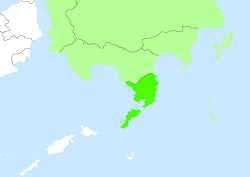United States of the Tao
United States of the Tao タオの合衆国 Tao no gasshūkoku | |||||||||
|---|---|---|---|---|---|---|---|---|---|
| 1947–2019 | |||||||||
| Motto: Tao ni shitagau Follow the Tao | |||||||||
 Map showing the UST's territories | |||||||||
| Capital | Ein | ||||||||
| Common languages | Japanese English Aoban | ||||||||
| Religion | Taoism (de facto) | ||||||||
| Government | Constitutional Republic | ||||||||
| Legislature | Chancellory | ||||||||
| House of Chancellors | |||||||||
| House of Representatives | |||||||||
| Historical era | Modern | ||||||||
• Surrender in WWII | October 30, 1947 | ||||||||
• Established | November 1, 1947 | ||||||||
• Constitution | May 19, 1948 | ||||||||
• Dissolved | May 16, 2019 | ||||||||
• Monarchy Reestablished | May 17, 2019 | ||||||||
| Area | |||||||||
| 2018 | 886,067 km2 (342,112 sq mi) | ||||||||
| Population | |||||||||
• 2018 | 108,000,000 | ||||||||
| Currency | Taoist Way (₩) (WAY) | ||||||||
| |||||||||
The United States of the Tao, sometimes referred to as the UST or simply, Tao; was an independent state in South East Ophion in Sunalaya. The UST was made up of two main landmasses, one connected by land to the rest of Ophion (northern border), and Aoba island, along with a multitude of other smaller islands.
Etymology
"Tao" /dou,tou/
The United States of the Tao had adopted its name from the previous ruling entities, the Republic of the Tao, and the Empire of the Tao. Both of which had taken on the name of which the area had been called for thousands of years.
The exact origin of the name "Tao" is still unknown and heavily disputed.
Government
The UST was a Chancellatorial Constitutional Republic. Under its constitution it was to be referred to as the "The Taoist Republic of the United States of the Tao", however, it also noted that in all official documentation and references, it should be simply referred to as the "United States of the Tao". Its government is made up of four branches: Executive, Judicial, Legislative.
Military
The United States of the Tao has four branches: Army, Navy, Airforce, and Coast Guard. Each branch has a Chancellor which are elected but must qualify through military service in said branch, each branch also has a Deputy Chancellor who is appointed by that branch's Chancellor, though all deputies must also qualify through military service. While each branch has its own Chancellor, there is also the Chancellor of Defence and the Deputy Chancellor of Defence, both of whom are elected and must not have enlisted military service; this allows civilians and those who have been active in the military as officers but not enlisted men to run for Chancellor and Deputy Chancellor of Defence.
Each branch of the Military acts independently but answer to, and coordinate through, the Chancellor of Defence. None of the branches have the authority to make or declare war on their own, these actions must be initialized by the Prime Chancellor and authorized by the Chancellor of Defence. Any international bases are under the command of the military and the Chancellor of Defence, as they are all classified as joint bases, even if there is only one branch occupying and holding operations there.
